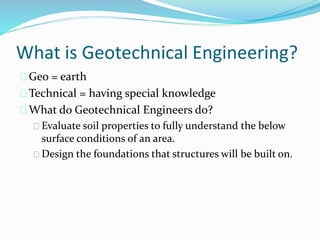Some Known Incorrect Statements About Geotheta
Some Known Incorrect Statements About Geotheta
Blog Article
Geotheta Fundamentals Explained
Table of ContentsHow Geotheta can Save You Time, Stress, and Money.Geotheta for DummiesThe 3-Minute Rule for GeothetaGeotheta Fundamentals ExplainedThe Main Principles Of Geotheta

They conduct site investigations, gather samples, execute laboratory examinations, and assess data to review the suitability of the ground for building and construction tasks - Consulting Engineers. Based on their findings, geotechnical designers offer recommendations for structure design, slope security, maintaining structures, and mitigation of geotechnical risks. They work together with other professionals, such as architects, architectural engineers, and construction teams, to ensure that geotechnical considerations are integrated right into the overall task design and implementation
By examining the actions and residential or commercial properties of dirt and rock, they can identify prospective geotechnical risks such as landslides, dirt settlement, or slope instability. Their know-how assists protect against failures or accidents that could threaten lives and residential or commercial property. Here are some thorough duties and obligations of a geotechnical designer: Website Examination: Geotechnical engineers conduct website examinations to gather information on subsurface conditions.
They interpret the information to recognize the residential or commercial properties and behavior of the soil and rock, including their stamina, permeability, compaction characteristics, and groundwater conditions. Geotechnical Analysis and Layout: Geotechnical engineers assess the data accumulated throughout website investigations to evaluate the security and suitability of the website for building and construction projects. They execute geotechnical computations and modeling to review variables such as bearing capability, settlement, incline security, side earth pressures, and groundwater flow.
All About Geotheta
Foundation Design: Geotechnical designers play an essential function in developing structures that can securely support the desired framework. They analyze the dirt conditions and load needs to establish the appropriate structure kind, such as shallow structures (e.g., grounds), deep foundations (e.g (https://myanimelist.net/profile/geotheta)., heaps), or specialized strategies like dirt improvement. They think about elements such as negotiation limitations, bearing capacity, and soil-structure interaction to create optimal foundation layouts
They evaluate construction plans, monitor website activities, and conduct area assessments to verify that the design suggestions are complied with. If unexpected geotechnical concerns occur, they evaluate the situation and give recommendations for remediation or changes to the design. Threat Evaluation and Mitigation: Geotechnical designers assess geotechnical hazards and threats connected with the project website, such as landslides, liquefaction, or dirt erosion.

Partnership and Interaction: Geotechnical designers function very closely with other professionals included in a job, such as designers, architectural designers, and construction teams. Reliable interaction and partnership are important to integrate geotechnical factors to consider into the overall task design and building and construction procedure. Geotechnical engineers supply technical experience, response questions, and ensure that geotechnical demands are met.
About Geotheta
Below are some types of geotechnical designers: Foundation Engineer: Foundation engineers concentrate on designing and examining structures for frameworks. They evaluate the dirt problems, lots requirements, and site features to determine one of the most appropriate structure kind and style, such as superficial structures, deep structures, or specialized strategies like heap foundations.
They assess the elements influencing incline stability, such as dirt residential or commercial properties, groundwater conditions, and slope geometry, and establish methods to stop incline failings and mitigate risks. Earthquake Designer: Earthquake designers focus on examining and creating frameworks to stand up to seismic forces. They examine the seismic hazard of a website, review soil liquefaction capacity, and establish seismic layout requirements to make sure the security and resilience of structures during quakes.
They carry out field testing, accumulate examples, and examine the collected information to identify the soil homes, geologic developments, and groundwater problems at a website. Geotechnical Instrumentation Designer: Geotechnical instrumentation engineers concentrate on monitoring and measuring the actions of soil, rock, and frameworks. They set up and maintain instrumentation systems that monitor variables such as dirt settlement, groundwater levels, incline motions, and structural variations to evaluate performance and supply early warnings of possible issues.
Geotheta for Dummies
They perform tests such as triaxial tests, combination examinations, direct shear tests, and leaks in the structure tests to gather information for geotechnical evaluation and layout. Geosynthetics Designer: Geosynthetics designers concentrate on the layout and application of geosynthetic materials, such as geotextiles, geogrids, and geomembranes. They make use of these materials to improve soil stability, strengthen inclines, offer water drainage services, and control disintegration.
They have a tendency to be investigative individuals, which indicates they're intellectual, reflective, and investigative. They wonder, methodical, sensible, logical, and sensible. A few of them are also social, implying they're kind, charitable, cooperative, person, caring, helpful, compassionate, sensible, and friendly. Does this noise like you? Take our cost-free profession examination to learn if geotechnical designer is just one of your leading career suits.
In the workplace atmosphere, geotechnical designers make use of specialized software program devices to carry out computations, create styles, and evaluate information. They prepare reports, review task specifications, communicate with customers and group members, and coordinate job tasks. The office setting gives a conducive environment for study, evaluation, and collaboration with other professionals entailed in the job.
See This Report about Geotheta
They regularly go to task websites to perform website examinations, evaluate geotechnical problems, and collect information for analysis. These brows through involve traveling to different places, occasionally in remote or difficult terrains. Geotechnical engineers might perform soil tasting, conduct tests, and screen building and construction tasks to guarantee that the geotechnical elements of the project are being carried out correctly.
Geotechnical designers also operate in specialized geotechnical laboratories. In these facilities, they carry out experiments, do tests on dirt and rock samples, and examine the engineering homes of the products. Geotechnical lab engineers work extensively in these atmospheres, dealing with screening devices, operating instruments, and videotaping data. They team up with various other lab personnel to make certain exact and trustworthy screening outcomes.
Report this page